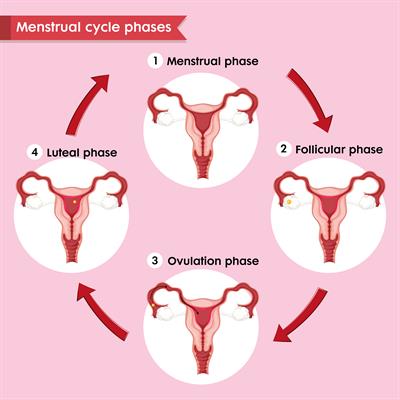PDF chapter test TRY NOW
Reproduction is very important for the continuation of the species.
The reproductive phase means the ability to produce the gametes for fertilisation.
With the onset of puberty, adolescents can reproduce due to the production of gametes or sex cells (ova or egg in females, sperms in males). The ability to produce gametes in humans lasts only for a specific period. The period varies between the males and the females.
In females, the reproductive phase starts from puberty, i.e., \(10\) to \(12\) \(years\) of age, and lasts up to \(45\) to \(50\) \(years\). In males, the production of gametes starts at the age of \(13\) and lasts for a longer when compared to females.
Reproductive phase in female:
Menarche:
The first menstrual flow that occurs at puberty is termed menarche.
From puberty, the eggs or ova start to mature in the ovary. Menarche is the beginning of adolescence, where there is mental and emotional maturation with physical growth. It is the beginning of the reproductive life in girls. The menstrual cycle halts when a woman is pregnant. But the menstrual cycle stops when the women reach the age of (45\) to \(50\) years.
Ovulation:
Ovulation occurs approximately in \(14\) days before the next menstrual cycle. One ovary releases the mature ovum once in \(28\) to \(30\) days.
The release of the ovum from the ovary is called ovulation.
During this time, the inner lining of the uterus grows and thickens to receive the fertilized egg, if fertilisation occurs, this leads to pregnancy.
Pregnancy:
After ovulation, the ovum reaches the fallopian tube. When the sperm meets the ovum at the fallopian tube, fertilisation occurs. If fertilisation occurs, the fertilised cell or the zygote develops to form an embryo. The embryo then gets embedded or implanted in the uterus.
The corpus luteum grows continuously to produce a large amount of progesterone, and leads to pregnancy. Pregnancy lasts for \(280\) \(days\) till the parturition.
Menstruation:
When fertilisation of the ovum does not occur, the thick lining of the uterus (corpus luteum) sheds along with the unfertilised egg and blood vessels. The production of the hormones estrogen and progesterone ceases. This causes bleeding in the woman's reproductive tract that is called menstruation in females. Menstruation thus occurs once in \(28\) to \(30\) days.
Menstruation takes about \(3\) to \(5\) days. In some people, the menstrual cycle may be irregular initially. It can take some time to become regular.
When menstruation stops, it is called menopause.
Women stop ovulating at menopause, and menstruation stops permanently. Hormones control the menstrual cycle.
Menstruation takes about \(3\) to \(5\) days. In some people, the menstrual cycle may be irregular initially. It can take some time to become regular.
When menstruation stops, it is called menopause.
Women stop ovulating at menopause, and menstruation stops permanently. Hormones control the menstrual cycle.

Menstrual cycle
Reference:
https://www.vecteezy.com/vector-art/1361046-scientific-medical-illustration-of-menstral-cycle-process
